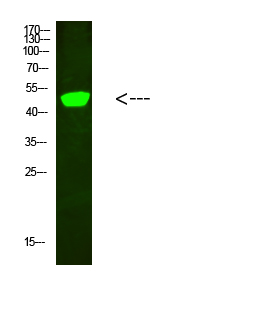产品名称
C1RL Rabbit Polyclonal Antibody
别名
Complement C1r subcomponent-like protein (C1r-LP) (C1r-like protein) (EC 3.4.21.-) (C1r-like serine protease analog protein) (CLSPa)
存储缓冲液
Liquid in PBS containing 50% glycerol, 0.5% BSA and 0.02% New type preservative N.
Human Gene Link
http://www.ncbi.nlm.nih.gov/sites/entrez?db=gene&term=51279
Human Swissprot No.
Q9NZP8
Human Swissprot Link
http://www.uniprot.org/uniprotkb/Q9NZP8/entry
Mouse Swissprot No.
Q3UZ09
Mouse Swissprot Link
http://www.uniprot.org/uniprot/Q3UZ09
免疫原
Synthesized peptide derived from human C1RL. at AA range: 371-420
特异性
C1RL Polyclonal Antibody detects endogenous levels of C1RL
稀释度
WB 1:500-2000, ELISA 1:10000-20000
宿主
Polyclonal, Rabbit,IgG
背景介绍
caution:Does not associate with the C1 complex. According to PubMed:15385675 doesn't cleave the proform of complement C1s.,function:Mediates the proteolytic cleavage of HP/haptoglobin in the endoplasmic reticulum.,induction:Up-regulated in monocytes and dendritic cells (DC) undergoing maturation or activation.,similarity:Belongs to the peptidase S1 family.,similarity:Contains 1 CUB domain.,similarity:Contains 1 peptidase S1 domain.,tissue specificity:Highly expressed in placenta, liver, kidney, pancreas, moderately in lung, spleen, prostate, ovary, colon, and PBL, and weakly in heart, skeletal muscle, thymus, testis, and small intestine. Expressed in PC-3 (prostate adenocarcinoma) and SK-OV-3 (ovary adenocarcinoma) cells, but not in LoVo and HT-29 (colon adenocarcinoma), SMMC7721 (hepatocellular carcinoma), CaoV-3 (ovary adenocarcinoma), HeLa (cervix epithelioid carcinoma), MCF-7 (breast adenocarcinoma), U251 (glioma) or A549 (lung carcinoma) cells. Widely expressed in myeloid leukemia cell lines, including K-562 (chronic myelogenous leukemia), THP-1 (myelomonocytic leukemia), HL-60 and NB4 (promyelocytic leukemia), and KG-1 (acute myelogenous leukemia) cells. Expressed mainly in the liver and in serum (at protein level).,
组织表达
Highly expressed in placenta, liver, kidney, pancreas, moderately in lung, spleen, prostate, ovary, colon, and PBL, and weakly in heart, skeletal muscle, thymus, testis, and small intestine. Expressed in PC-3 (prostate adenocarcinoma) and SK-OV-3 (ovary adenocarcinoma) cells, but not in LoVo and HT-29 (colon adenocarcinoma), SMMC7721 (hepatocellular carcinoma), CaoV-3 (ovary adenocarcinoma), HeLa (cervix epithelioid carcinoma), MCF-7 (breast adenocarcinoma), U-251MG (glioma) or A-549 (lung carcinoma) cells. Widely expressed in myeloid leukemia cell lines, including K-562 (chronic myelogenous leukemia), THP-1 (myelomonocytic leukemia), HL-60 and NB4 (promyelocytic leukemia), and KG-1 (acute myelogenous leukemia) cells. Expressed mainly in the liver and in serum (at protein level).
功能
caution:Does not associate with the C1 complex. According to PubMed:15385675 doesn't cleave the proform of complement C1s.,function:Mediates the proteolytic cleavage of HP/haptoglobin in the endoplasmic reticulum.,induction:Up-regulated in monocytes and dendritic cells (DC) undergoing maturation or activation.,similarity:Belongs to the peptidase S1 family.,similarity:Contains 1 CUB domain.,similarity:Contains 1 peptidase S1 domain.,tissue specificity:Highly expressed in placenta, liver, kidney, pancreas, moderately in lung, spleen, prostate, ovary, colon, and PBL, and weakly in heart, skeletal muscle, thymus, testis, and small intestine. Expressed in PC-3 (prostate adenocarcinoma) and SK-OV-3 (ovary adenocarcinoma) cells, but not in LoVo and HT-29 (colon adenocarcinoma), SMMC7721 (hepatocellular carcinoma), CaoV-3 (ovary adenocarcinoma), HeLa (cervix epithelioid carcinoma), MCF-7 (breast adenocarcinoma), U251 (glioma) or A549 (lung carcinoma) cells. Widely expressed in myeloid leukemia cell lines, including K-562 (chronic myelogenous leukemia), THP-1 (myelomonocytic leukemia), HL-60 and NB4 (promyelocytic leukemia), and KG-1 (acute myelogenous leukemia) cells. Expressed mainly in the liver and in serum (at protein level).,
纯化
The antibody was affinity-purified from rabbit antiserum by affinity-chromatography using epitope-specific immunogen.

